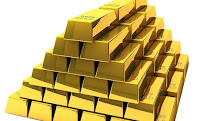What Factors Affect The Price Of The Precious Metals?
Factors That Affect The Price Of Precious Metals
What factors affect the price of the Precious Metals?
Gold and Silver market values fluctuate all throughout the
day and night, trading worldwide nearly 24 hours a day now. Many
economic and political factors influence the physical Gold and Silver market price, known as the SPOT price. Some of the most notable factors include: current
and long-term interest rates, the current rate of inflation, Gold &
Silver's physical supply and the physical demand for them,
speculator/investor purchases and sales, the current value of the US
Dollar as a currency, large metals transactions made by Central
Banks around the world, and of course, unforeseen events that can rapidly reshape whole economies.
The Fed's Monetary Policies. The Federal Reserve is a privately-owned group of banks that controls the U.S. supply of money in the market to keep the economy growing at a pre-selected rate, or contracting when necessary to slow the economy. The Fed is also the lender of last resort to the U.S. Government, a feature that's basically a printing press of money as long as the USD remains the World's Reserve Currency. A dovish Fed policy, also known as expansionary policy, weakens the Dollar's purchasing power as the money supply expands. When buying precious metals with a weaker Dollar, it takes more of those weaker Dollars to buy an ounce of metal. In contrast, a hawkish monetary policy, a policy of money supply contraction, strengthens the Dollar's value. When buying precious metals with a stronger Dollar, it takes less of those stronger Dollars to buy that same ounce of metal. The Federal Reserve has created approximately $5 Trillion new Dollars in the past couple of years, and the U.S. Government, or more accurately, the U.S. taxpayers, are on the line to pay those magically created Dollars back. Take a Dollar bill out of your purse or wallet and read the top line, it says "Federal Reserve Note". We have a house note, a car note, etc., and the note is evidence of that debt. Sadly, our money in circulation is no different, we owe the Federal Reserve the amount of that "Note". In America, we are using debt as an asset to buy things and it's a recipe for economic disaster.
Economic Events. Movements in the U.S. economic events determines the current Exchange Rate of the Dollar against other countries. Major economic events include the GDP, Employment Change and Labor Participation Rate, U.S. Industrial Production, the Trade Deficit against other nations, and the Consumer Price Index. Better than forecasted data hikes the demand for Dollars and raises the value of the U.S. Dollar, causing a drop in metals’ prices, and vice versa.
Gold & Dollar. Since Gold is mostly priced in U.S. Dollars, it is, for the most part, inversely-correlated with the value of the Dollar. When there is a broad weakening of the Dollar against other currencies, these currencies automatically have more Gold purchasing power, since Gold is priced in Dollars. The effect is often that the demand for Gold increases, which in turn raises the Gold price up to the point where it reaches a temporary state of homeostasis.
Supply Changes. A new mine discovery, or new & improved mining industry techniques, may somewhat increase the available supply of a certain Precious Metal, but it’s more often that we see a supply disruption limiting the supply of a particular Precious Metal. A mine flood or cave-in, a strike by mine workers, or newly imposed environmental rules or restrictions, are some of the typical supply disruptions we have seen in the Precious Metals industry in the past few decades. High-tech metals like Platinum and Palladium are especially susceptible to supply disruptions as the vast majority of production of these two metals occurs in only two countries, Russia and South Africa. These metals are needed for high-tech industrial applications and are often subject to governmental stockpiling and restricted usage. For example, Platinum jewelry was very popular in the 1920’s and 1930’s, but its jewelry usage was stopped completely at the start of World War 2 because the available supplies were needed for strategic industries and the war production effort. If the mining production of Platinum and Palladium was suddenly disrupted today, above ground stockpiles would be quickly used up, and industrial and high-tech production of things like automobiles, fiber optic cables and certain medicines would grind to a halt.
Major Political Announcements, Crises, Natural Disasters, Military Conflicts, etc. Besides scheduled reports of economic events, political elections or government shakeups, military conflicts, terror incidents, natural disasters and the like, can all cause severe variations within the ratio of Dollars to Precious Metals. Oftentimes in a crisis, there is a very observable “flight to quality” reaction where investors move their money to assets deemed safe and readily liquid worldwide, usually the U.S. Dollar and Precious Metals, primarily Gold. In these scenarios, you will often see Precious Metals and the Dollar moving up in value together instead of moving in opposite directions like they typically would. At some point in the future when the diminishing trust in the U.S. Dollar system becomes more evident, it’s likely that Precious Metals will be the ultimate safe haven, the last asset standing. It’s also possible, maybe even likely, that we may see a period of time in the future where ALL asset classes drop in value, including Precious Metals. In that case, it will be a situation where everyone loses, but it’s our financial planning job to preserve the most value we can, and lose the least.



Comments
Post a Comment